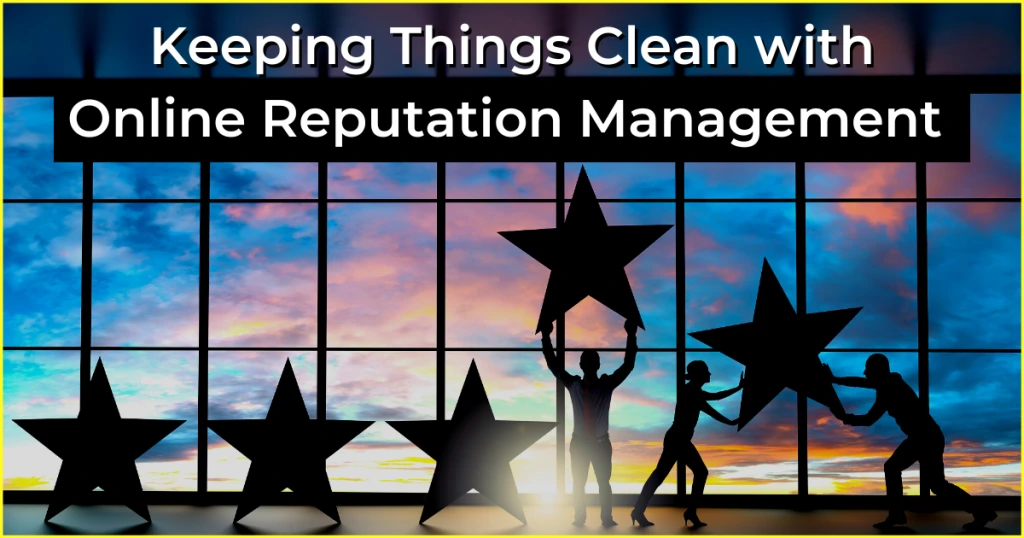Keeping Things Clean With Online Reputation Management

“I don’t care what they think about me.”
Sounds very punk, right?
Well, that’s a statement you cannot use when you own a big brand.
In this era of digital marketing, the online reputation of a brand can make it or break it. Picture a brand being cut off on all social media platforms and tons of negative reviews flowing in from every direction. Do you think a brand can maintain its sales and survive in the market without caring about what people think of them?
How harmful can it be for a brand, anyway?
It’s 2022 and a bad reputation online can do more damage than ever before. Imagine, you are searching for a new smartphone. What’s the first thing you do after short-listing a couple of options? You read their reviews!

Now, if you read more bad reviews than good ones, the chances are you will drop the idea of buying them. What people think, say, or write about your brand on digital platforms, i.e. social media posts, comments, online reviews, etc, impacts your sales hugely. Even bad reviews about your brand can drive your potential customers to your competitors!
So, what do brands do to tackle it?
With the rise of powerful social media platforms and a generation of customers that is very conscious about the brands that they purchase from, it is imperative for brands to maintain their online brand image and reputation. This is the reason big brands with an established image invest a lot of money into Online Reputation Management.
What’s Online Reputation Management (ORM)?
The first instinct of people when they get to know about a new brand that they’ve never come across before is to Google about it. So, naturally, they make their first perception about the brand according to whatever shows up first on the search results.
For example, if neatly curated positive information mixed with good reviews shows up first, a person will naturally think highly of the brand. But if things like negative reviews or articles about the controversies that the brand has sparked show up first, the first impression might not be very positive.
Online Reputation Management is controlling what people see when they search your brand. It makes sure that when someone tries to know more about your brand, they start with positive information. The ideal ORM strategy includes review management, social media marketing, public relations management, search engine optimization, and customer service tactics.
To keep a more positive and cleaner brand image, brands may use specific digital channels. Creating and maintaining an overall positive brand perception, all these channels need to be managed strategically.
The common channels that big brands use for their ORM can be broken down as;
Owned Media: Any media that your brand controls i.e. blogs, website, etc.
Earned Media: All free exposure and coverage that your brand gathers; press coverage, third-party review sites, third-party listings (Glassdoor, Trustpilot), and articles about you on others’ blogs.
Shared Media: This covers any kind of content marketing that you ‘share’ with others i.e. social media posts, podcasts, etc. While you still own them, anyone can publically comment on them negatively or positively.

Paid Media: Simply put, if you are paying for your brand to get featured, it’s paid media i.e. Google ads, Microsoft ads, LinkedIn sponsored messaging, etc.
With dedicated teams to handle sticky situations, big brands tend to use specific techniques for their ORM strategy, Here are some such techniques:
- Doing 360-degree brand audits
- Monitoring brand mentions
- Responding to negative reviews
- Investing in the brand’s SEO
- Leveraging their PR activities
- Encouraging customers reviews on trustworthy review sites
- Promoting positive content about the brand
Now, let’s look at some big brands that did ORM the right way and saved themselves from online disasters!
Got a complaint? @TeamNike is here for you!
No matter how much content a brand gives out, how well they collab with leaders of the industry, or how creative marketing they do, nothing screams “We care” like responding to customer complaints and negative reviews!

This is exactly what Nike wanted to reflect in their ORM strategy and thus created @TeamNike Twitter handle. This account is solely for listening and responding to customer complaints on an open social media platform like Twitter. This helps Nike keep all the complaints in one hub and also lets people see how much they care about their customers and their complaints!
As a result, Nike becomes an all-time favorite for consumers; not just based on its products but also because of its customer-centric brand image.
Starbucks says sorry!
The popular coffee chain, Starbucks is known for its customer-centric policies. They treat their customers like kings and make sure that each of their customers is happy with their coffee as well as the service they provide. This sometimes even results in free drink vouchers for the next visit when someone’s order is delayed or their famous ‘free birthday drinks’.

However, Starbucks too once found itself in a sticky situation where it faced heavy backlash for racial bias. As a video of the incident went viral, where two African-American men were wrongfully arrested just for sitting at a Starbucks cafe, the brand saw much reputation damage on the internet.
Starbucks tackled it by apologizing for the incident and closed 8000 stores across the U.S. for ‘racial bias education.’
Corporate disaster or marketing? Learn it from KFC.
A fried chicken franchise with no chicken??? Now that sucks more than Mondays.
After KFC made a shift to its new delivery partner DHL, they went into a grave crisis. As #KFCCrisis trended on Twitter, the brand had to close hundreds of its stores as they ran out of chicken! This was supposed to be a full-blown corporate disaster until KFC owned up to this blunder.
They started an OMR ‘campaign’ where both KFC and DHL apologized for the situation while the ads feature an empty KFC bucket with their initials scrambled up as ‘FCK’.
Just like always, KFC had won over people with the help of humor while turning a potential disaster into a marketing opportunity.
Is it only for Brands, though?
Sometimes, even one person’s actions from a brand can put the brand’s image at stake. For example, any inappropriate behavior, controversial comment, or insensitivity shown by the CEO of a company can bring in social media storms for the brand itself. In situations like this, brands require OMR to recover from the damage done by the specific individual’s action.
Similarly, individuals who themselves are a brand i.e. sportsmen, actors, politicians, or any kind of celebrity require Online Reputation Management too. Since they are always in the spotlight, even the smallest mistake or the rumor about a supposed mistake can damage the reputation of the person. Such damage usually affects the individual personally and professionally.
Remember when Justin Bieber saw the darkest time of his life and made it worse by egging his neighbor’s house? Well, that’s the kind of situation where a celebrity needs ORM to get out of sticky situations induced by their momentary frustration.
One of the easiest ways most celebrities take to maintain their online reputation is by giving their fans what they want; glimpses of their personal lives. Vin Diesel took the same route and emerged as one of the internet’s favorite celebrities just by posting peeks into his everyday life.
With the power dynamics shifting to digital platforms, brands need to have a clean image online to survive and thrive in the market. Since the online image can be the literal face of the brand itself, people must see positive information about your brand when they search it up which makes Online Reputation Management a must-do practice for all brands!


Comments are closed.